In November 1998 I went to Paris for the first time. The circumstances under which I went seem hardly believable now. At the time I was working as a designer for an agency in London’s Soho district. This was my first job after university, and I’d only been there a year, but it had been a good year, and I’d been constantly busy with interesting projects. It had also been a good year for the company, so much so that our directors rewarded us, some fifty employees, with a weekend in Paris!
By 1998 the Eurostar service had already been running between London and Paris for four years. In those days trains bound for Paris did not yet embark from St Pancras on a high-speed rail link. Instead they left from Waterloo, slowly threading themselves along existing railway lines through the suburbs of south London. I know this because they passed through the town where I lived, and I frequently watched them as they slid underneath me while I crossed the railway bridge on my own way to the station. I never tired of seeing the Eurostar trains. They had a distinctive noise so that you always knew when one was approaching. It was a thrilling sight, knowing that they were headed for Paris or Brussels, and it sounds sad and strange to write this now but, back then, there was a sense of excitement at having an international train service leaving London, a train service that brought us closer to our continental neighbours.

And so, on a Friday evening in late November 1998, about fifty of us took the underground from Tottenham Court Road to Waterloo, and boarded a Eurostar train to Paris. The atmosphere was party-like. We were a close group of people, mostly young, and when you work in a design studio in London’s Soho district, you’re going to embrace the ‘work hard, play hard’ ethic. And that we did. There was a real sense of camaraderie amongst us, and to me it felt as though I were part of an extended family.
It was past 9pm by the time we arrived at Gare du Nord. We checked into our hotel, a cheap affair situated just a few hundred yards away from the station, before congregating on the busy intersection of the Boulevards de Strasbourg and de Magenta, as we attempted to collectively decide what to do and where to go next. As we stood and chatted, scores of rollerskaters glided past us, blowing whistles and handing out packets of condoms as they went.
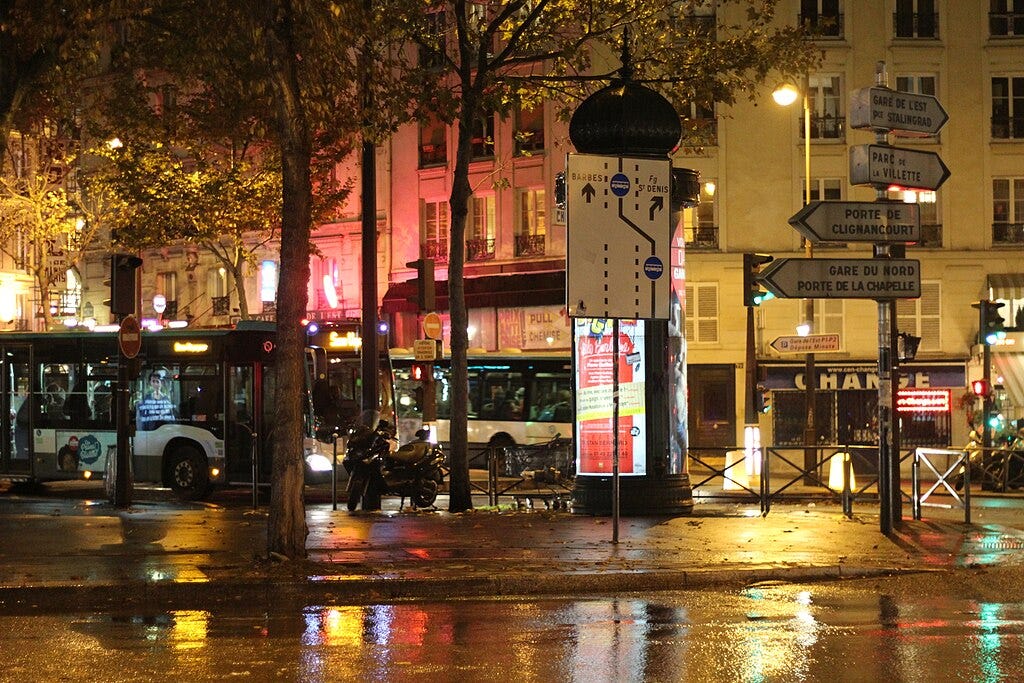
I was standing and talking with my two closest work colleagues: S, a fellow designer, and A, a programmer. Nothing was happening yet, and no overarching decisions had been taken. The three of us stood off to one side from the main group, and I remember how we all looked at each other, and how our expressions all said the same thing: let’s go.
So we wandered off down the Boulevard de Strasbourg, with the intention of finding a bar and a beer. The first place of interest we eoncountered was the Passage Brady, its entrance beckoning us in. Inside we found lots of Indian restaurants, but we also found a bar, and made ourselves comfortable. I was utterly unaware at the time of how obsessed with the Parisian passages I would later become, but I was still some five years away from learning the names of Charles Baudalaire and Walter Benjamin.
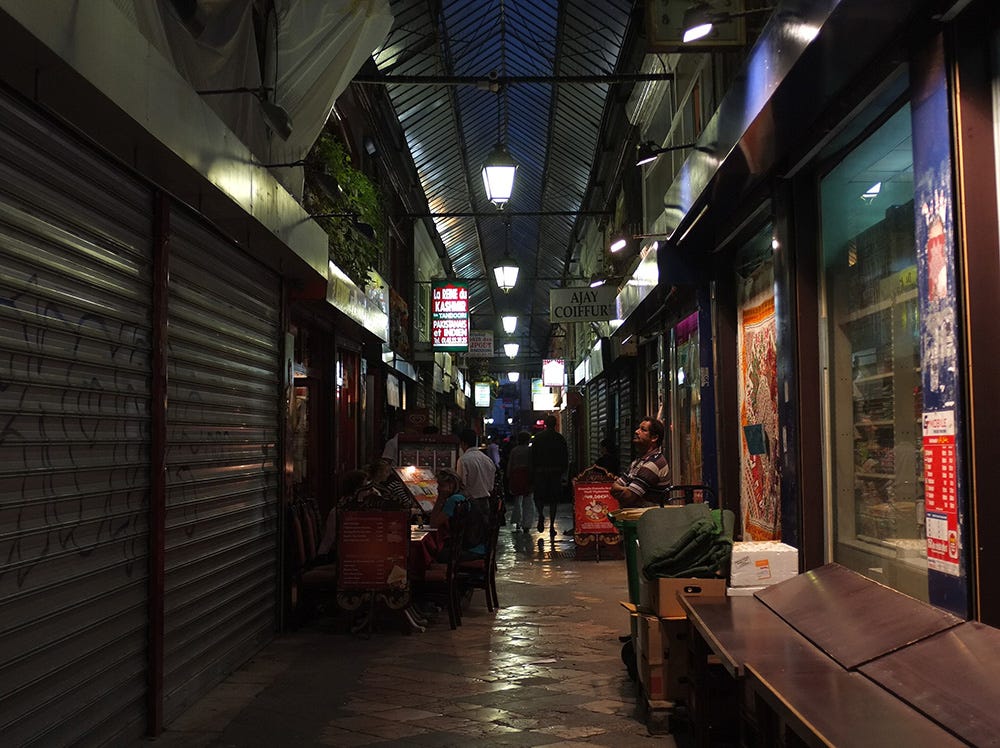
It was gone 11 by the time we left the Passage Brady. We carried on walking down the Boulevard de Strasbourg and onto the Boulevard Sébastopol, past drunkards, pimps, and prostitutes. As we walked we got the sense that we were closing in on the centre of the city, because every now and then we’d catch a glimpse down a sidestreet of some grand building, Les Halles, the Pompidou Centre. And then suddenly the vista opened up, and we were looking out across the Seine, and crossing the Pont au Change onto the Île de la Cité.
“At last I have come into a dreamland”
Harriet Beecher Stowe
The streets were much emptier here, it was nearly midnight after all. We found a bistro that was still open and ordered Steak Frites, washed down with an easy drinking red wine. After our dinner we headed over to Nôtre Dame, and then across the river to the Left Bank, where we found a café on the brink of closing for the night, that served us Irish coffees.
By now, we knew that there was no stopping us. If we had a map between us, we weren’t using it. Instead, we were choosing our route purely on instincts. It was exhilarating.
In the early hours of the morning we arrived at the Musée d’Orsay. There was no one about, and the museum was shrouded in darkness. A handful of streetlamps dimly illuminated the courtyard in front of the museum’s main entrance. Our attention was drawn to six statues at the rear of the courtyard, mounted on a single low plinth. The statues were of six women; allegorical figures that I later learned represented the six continents, and which had previously adorned the gardens of the Trocadero for the 1878 Exposition Universelle. S clambered onto the plinth to get a closer look at one of the statues. He was still and silent for a moment, and then, with a voice rising in excitement, instructed us to look into the eyes of the figures. So we did. We clambered up, placed our hands on the statues’ shoulders to put ourselves at arms’ length from their faces, found the right angle to be able to stare right into the eyes, and then looked… What an intense moment, an exhilaration, as these statues scowled back at us with an intensity that was unnerving. You never get the opportunity to look at such statues in this way, eye to eye. No doubt if we’d tried to do what we did now during the day, we would have been hauled off and severely admonished by the museum’s security.
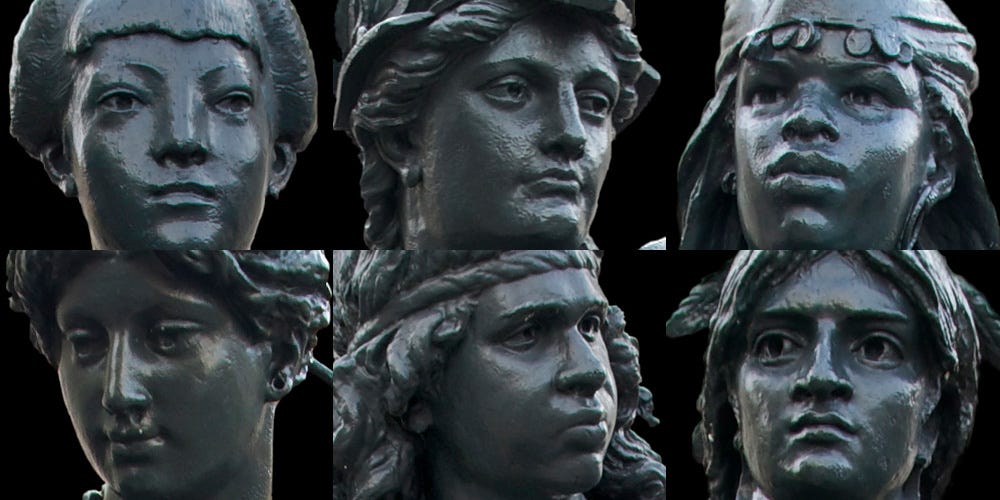
We left the Musée d’Orsay in something of a daze, and while I’ve returned to Paris many times since, and explored the contents of the Orsay, as well as the Louvre, the Pompidou Centre, and a host of other galleries and museums, I don’t think I’ve ever come away quite as transformed by the power of art as I did on that night.
“A walk about Paris will provide lessons in history, beauty, and in the point of Life”
Thomas Jefferson
Our next stop along the Left Bank was an Irish bar. The place was quiet and unassuming on the outside, just a lit doorway suggesting somewhere that was still open. But inside, more intensity, of warmth and vibrancy, noise and music, laughter and pints of Guiness. We staggered out an hour later, and eventually found ourselves at the Eiffel Tower. It was 3am in the morning now, and the square underneath the tower was empty. We stood at its centre, gazing up into the structure’s dense and intricate iron framework, dimly lit against an indigo sky.
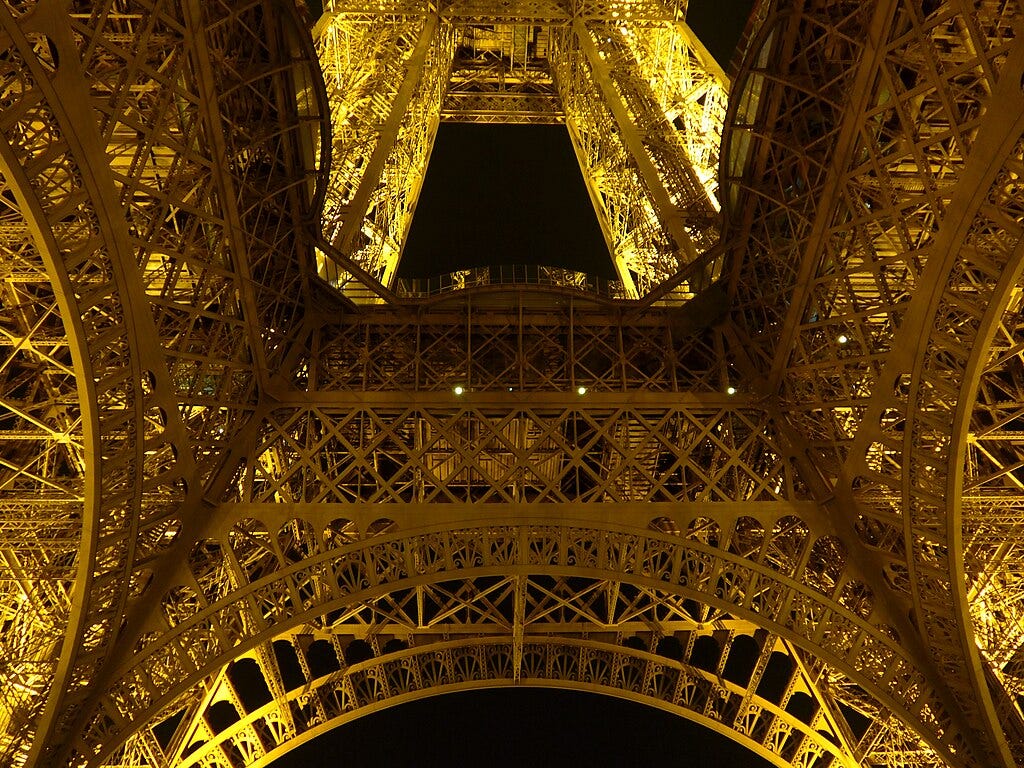
With the Eiffel tower to our backs we crossed the Seine on the Pont d’Iéna, and headed into the grounds of the Trocadero. From the other side of the river we had a good view of the tower. It was illuminated at this time with a countdown of days until 31 December 1999 and the start of the new millennium, and on that particular night, as we stared up at the tower, the number read 399.
A funfair occupied the open space between the Trocadero and its fountains and lawns. The rides and stalls were shuttered and secured for the night, but still, there was nothing to stop us wandering through the deserted amusements. A large carousel stood at the centre, its contents encased in a tarpaulin held together by large zips. It was easy enough for us to pull down one of the zips and step inside the carousel. And here was another wondrous moment, standing in the gloom amidst horses that would normally be prancing up and down, whirling round and round, bathed in dazzling lights and accompanied by the sound of a fairground organ. But here, in this ethereal halflight, amongst their silhouetted static forms and rigid stares, it was as though we had stepped into Medusa’s lair.
Leaving the Trocadero behind, we headed up the Avenue Kléber to the Arc de Triomphe. Here there were signs of life, in the form of taxis and cars orbiting the illuminated arch at its centre. We were flagging by the time we got to the Champs-Élysées at around 5am. We found a café that was open, an elegant affair with a black-and-white chequerboard tiled floor, carved woodwork, mirrored walls and ferns. We sat down and revived ourselves with beer and coffees, and I remember that we chatted about the concept of genius, while waiting for the Metro to open.
“Paris at dawn is one of those rare cities where you get the impression that something worthwhile could actually happen to you.”
Pierre Assouline
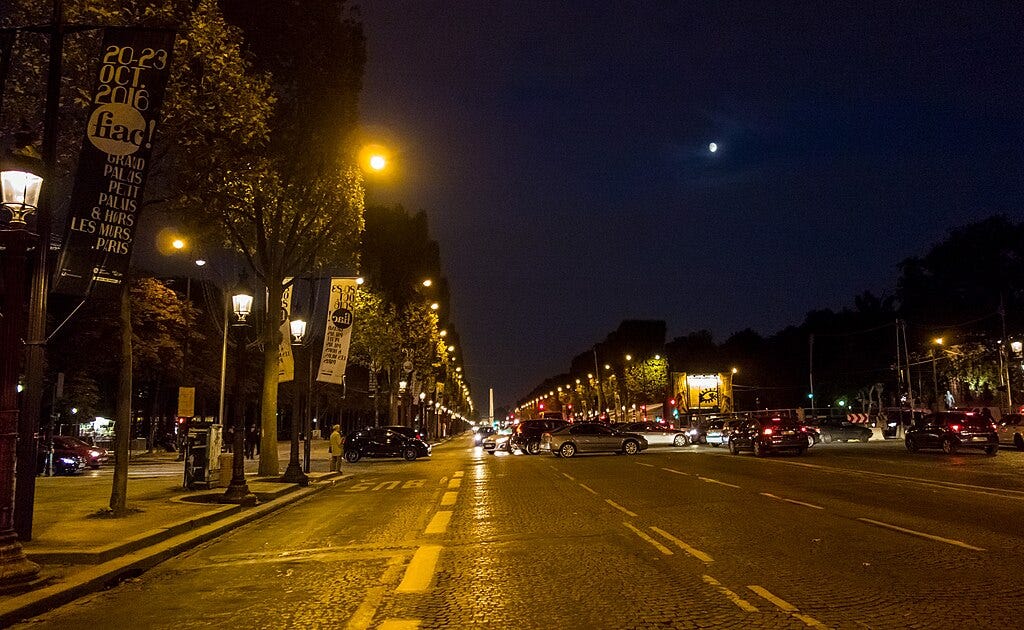
We got back to our hotel at around 7am, when dawn was only just beginning to make its presence felt in the sky to the east. We went straight to the breakfast room, in search of croissants and toast to soak up the night’s alcohol. Over the next hour or so our colleagues – clean, showered, washed – trickled down from their rooms to breakfast, to find us dishevelled, unshaven and looking somewhat the worse for wear. But in spite of the hangover that was now kicking in, how happy I was, basking in our colleagues’ admiration of our nocturnal exploits, and in spite of knowing that, however many times I might return to Paris in the future, I would never top the experience of that first night in the City of Light.




When we arrived in Paris in 2019 we also had our first adventure at night. We saw the Eiffel Tower in her lit-up glory and a taxi driver gave us a short tour. I remember thinking how surreal it was that we were actually there; I’d been reading books set IN Paris for years, and now I wasn’t reading a book. Now I was there! It was amazing. This post stirred pleasant memories.